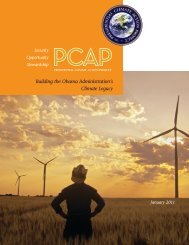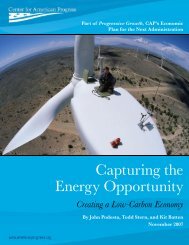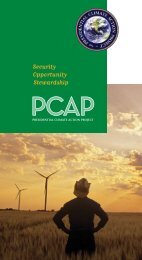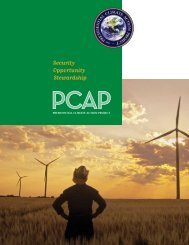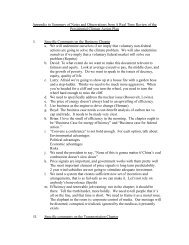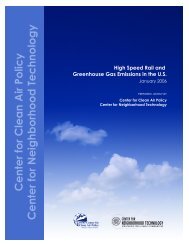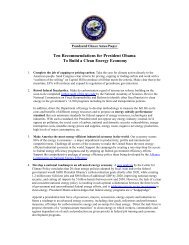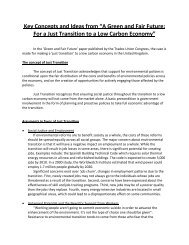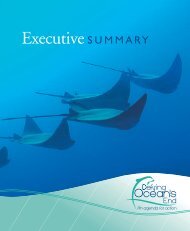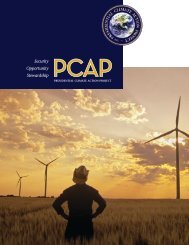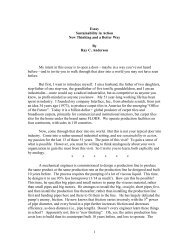species is listed as a threatened species, “the Secretary [of Interior] shall issue such regulations ashe deems necessary and advisable to provide for the conservation of such species.” 335Pursuant to the MMPA, “The Congress finds that . . . certain species and population stocks ofmarine mammals are, or may be, in danger of extinction or depletion as a result of man’sactivities . . . such species and population stocks should not be permitted to . . . diminish belowtheir optimum sustainable population. Further measures should be immediately taken toreplenish any species or population stock which has already diminished below that population.In particular, efforts should be made to protect essential habitats . . . . from the adverse effect ofman’s actions . . . .” 336 “[I]t is the sense of the Congress that they [marine mammals] should beprotected and encouraged to develop to the greatest extent feasible commensurate with soundpolicies of resource management and that the primary objective of their management should beto maintain the health and stability of the marine ecosystem . . . .” 337Given the science regarding the impacts of climate change, protecting these ecosystems, naturalresources, animals and the like (meeting the missions, goals and purposes of the laws) willrequire addressing climate change. Therefore, based on current scientific findings a duty toprotect the atmosphere is thus implied, or becomes inherent in most, if not all of these laws, inorder to protect the ecosystem, natural resource, animal, etc. 338Congress already explicitly recognizes the connection between changes in the atmosphere andthe management of traditional ecosystems both explicitly in congressional findings andimplicitly by supporting or requiring research in this regard, see, e.g., 15 U.S.C. § 2931(a)(2)(Congress finds that the consequences of global warming could adversely affect worldagricultural and marine production, coastal habitability, biological diversity, human health, andglobal economic and social well-being); 16 U.S.C. § 1447d (projects eligible for funding underthis act include research with respect to assessment of the effects of climate change on marineresources in the region); and 16 U.S.C. § 1601 (the report by the Secretary of Agriculture shallinclude an analysis of the potential effects of global climate change on the condition ofrenewable resources on the forests and rangelands of the United States). Excerpts from thesestatutes and others that bear on this point are included in Appendix A.3. Statutory provisions that this declaration is “consistent with.”The principle contemplated by this proposal implies duties that are consistent with and furtherthe purposes of a multitude of laws; for example, laws regarding energy conservation and energy335 Id. at § 1553(d).336 16 U.S.C. § 1361(1), (2)337 Id. at § 1361(6).338 Accord, U.S. <strong>Climate</strong> Change Science Program and the Subcommittee on Global Change Research, PreliminaryReview of Adaptation Options for <strong>Climate</strong>-Sensitive Ecosystems and Resources,” 1-1 to 1-6 (June 2008) (This reportprovides a preliminary review of adaptation options for climate-sensitive ecosystems and resources in the U.S. andexisting adaptation knowledge to support managers in taking immediate actions to meet their management goals inthe context of climate change. Within this context, the report presents a strategy for addressing climate changeunder current authorities: “with creative re-examination of current authorities their full capabilities could be appliedto address climate change impacts”).CEES 89 | P age
efficiency, (see Proposal A-2 for some examples); laws intended to reduce emissions by thegeneral public (see Proposal A-4 for some examples); and laws intended to reduce the emissionsof the federal government (see Proposal C-2), in addition to general air pollution laws.The following is a sample of relevant congressional declarations and findings that can be foundin these laws:a. National Energy Policy, Federal Energy Management. 339“It is the purpose of this part [Part B. Federal Energy Management] to promote the conservationand the efficient use of energy and water, and the use of renewable energy sources, by theFederal Government.” 340b. National Energy Conservation Policy, Chapter 91 of Title 42.“The purposes of this chapter are to provide for the regulation of interstate commerce, to reducethe growth in demand for energy in the United States, and to conserve nonrenewable energyresources produced in this Nation and elsewhere, without inhibiting beneficial economicgrowth.” 341 Further, “all sectors of the economy of the United States should continue to reducesignificantly the demand for nonrenewable energy resources such as oil and natural gas byimplementing and maintaining effective conservation measures for the efficient use of these andother energy sources.” 342c. Energy Independence and Security Act of 2007. 343“An Act to move the United States toward greater energy independence and security, to increasethe production of clean renewable fuels, to protect consumers, to increase the efficiency ofproducts, buildings, and vehicles, to promote research on and deploy greenhouse gas capture andstorage options, and to improve the energy performance of the Federal Government, and forother purposes.”d. Development of Energy Sources, Chapter 73 of Title 42.“The Congress hereby declares that the general welfare and the common defense and securityrequire effective action to develop, and increase the efficiency and reliability of use of, all energysources to meet the needs of present and future generations, to increase the productivity of thenational economy and strengthen its position in regard to international trade, to make the Nationself-sufficient in energy, to advance the goals of restoring, protecting, and enhancingenvironmental quality, and to assure public health and safety.” 344339 42 U.S.C. §§ 8251-8262k.340 Id. at § 8251.341 Id. at § 8201(b).342 Id. at § 8201(a)(4).343 Pub. L. No. 110-140, 121 Stat. 1498 (Dec. 19, 2007).344 42 U.S.C. § 5801(a) (emphasis added).CEES 90 | P age
- Page 1 and 2:
THE BOUNDARIES OF EXECUTIVE AUTHORI
- Page 4 and 5:
This page left intentionally blank.
- Page 6 and 7:
Proposal IndexPage NumberA Establis
- Page 8 and 9:
D-01 Direct the federal Climate Cha
- Page 10:
I. IntroductionThis report is a fol
- Page 16 and 17:
• The President shall not substit
- Page 18 and 19:
42, Chapter 77, Subchapter III expl
- Page 20 and 21:
In addition, it delegates to the Pr
- Page 22 and 23:
C. Presidential ProclamationsThere
- Page 24 and 25:
2. The developed country Parties an
- Page 26 and 27:
A. Establish National Energy and Ca
- Page 28 and 29:
the Nation, paying particular atten
- Page 30 and 31:
The President should establish the
- Page 32 and 33:
The President should establish the
- Page 34 and 35:
This proposal is framed in terms of
- Page 36 and 37:
partnership is working to reduce me
- Page 38 and 39:
Good candidate to implement by exec
- Page 40 and 41:
Executive Orders. There are 30 exec
- Page 42 and 43:
Congress annually a comprehensive r
- Page 44 and 45:
The Rural Utilities Services (RUS)
- Page 46 and 47:
through the energy policy, has some
- Page 48 and 49: Direct the EPA to work with the Chi
- Page 50 and 51: private members: E.O. 12216, the Pr
- Page 52 and 53: next 20 years.” 181 From the publ
- Page 54 and 55: Direct the EPA to immediately begin
- Page 56 and 57: scientific judgment.” 199 Further
- Page 58 and 59: Direct the EPA to immediately grant
- Page 60 and 61: of climate change in California are
- Page 62 and 63: Direct the EPA and DOE to collabora
- Page 64 and 65: The ATA is a private entity, and as
- Page 66 and 67: and Bioenergy, establishes an inter
- Page 68 and 69: Authority over the Entities Subject
- Page 70 and 71: Direct the DOT to reconvene the Cli
- Page 72 and 73: Direct NASA to restore earth scienc
- Page 74 and 75: Direct the Council on Environmental
- Page 76 and 77: C. Improve Federal StewardshipDirec
- Page 78 and 79: 3. Background.OMB performs legislat
- Page 80 and 81: There are numerous executive orders
- Page 82 and 83: Federal Energy Management Executive
- Page 84 and 85: 1973; (3) E.O. 12845, Requiring Age
- Page 86 and 87: This proposal is consistent with an
- Page 88 and 89: 4. GHG reduction goals to transport
- Page 90 and 91: President, but the President “may
- Page 92 and 93: Declare that it is the responsibili
- Page 94 and 95: 1. Statutory provisions that establ
- Page 96 and 97: whenever feasible; and disposal or
- Page 100 and 101: Determination of priorities which a
- Page 102 and 103: 3.2 Declaring that it is the respon
- Page 104 and 105: Management, (June 3, 1999) includes
- Page 106 and 107: economic, and other requirements of
- Page 108 and 109: environment.” Based on the polici
- Page 110 and 111: D. Protect American Taxpayers from
- Page 112 and 113: special committees but are expressl
- Page 114 and 115: Direct the federal Climate Change S
- Page 116 and 117: The CCSP is an executive branch age
- Page 118 and 119: E. Mobilize the MarketplaceDirect t
- Page 120 and 121: pollutants. Further, courts give gr
- Page 122 and 123: Direct the Council on Environmental
- Page 124 and 125: methods, and data related to sustai
- Page 126 and 127: F. Build Public-Private Partnership
- Page 128 and 129: printed in the Federal Register and
- Page 130 and 131: that officer or employee. Advisory
- Page 132 and 133: A-06A-07B-01B-02B-03B-04B-05B-06B-0
- Page 134 and 135: C-02.7C-02.8C-02.9C-03C-03.1C-03.2C
- Page 136 and 137: Appendix AStatutes with Specific Te
- Page 138 and 139: (C) assess the potential for the de
- Page 140 and 141: 15 U.S.C.A. § 657hTitle 15. Commer
- Page 142 and 143: (5) Climate fluctuation and change
- Page 144 and 145: (4) global data collection, and mon
- Page 146 and 147: 15 U.S.C.A. § 2932§ 2932. Committ
- Page 148 and 149:
implementation of any Federal actio
- Page 150 and 151:
(2) Projects eligible for funding u
- Page 152 and 153:
emissions associated with each type
- Page 154 and 155:
22 U.S.C.A. § 7902§ 7902. Reducti
- Page 156 and 157:
(c) Performance reviews and reports
- Page 158 and 159:
(3) Priority for integrated gasific
- Page 160 and 161:
[It is the purpose of this chapter
- Page 162 and 163:
(i) that no low greenhouse gas emit
- Page 164 and 165:
(3) prepare and transmit to the Con
- Page 166 and 167:
42 U.S.C.A. § 13384§ 13384. Asses
- Page 168 and 169:
(i) Selection of projects(3) In sel
- Page 170 and 171:
(1) In generalThe Secretary, in con
- Page 172 and 173:
(b) GoalsThe program shall have the
- Page 174 and 175:
Subchapter II. Energy Security thro
- Page 176 and 177:
Subchapter IV. Energy Savings in Go
- Page 178 and 179:
(B) to reduce emissions of covered
- Page 180 and 181:
§ 17334. Actions by overseas priva
- Page 182 and 183:
(5) be committed to minimizing admi
- Page 184 and 185:
Appendix BProclamations that Addres
- Page 186 and 187:
8) Proc. 7150, Nov. 20, 1998, World



